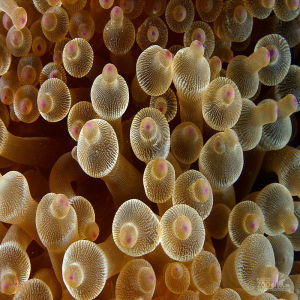 Bubble-tip anemone is one species of sea anemone. They can support (host) as many as 14 different species of anemonefish. The anemone appears in a variety of morphs, including rose, orange, red, and standard green. It can grow to be up to 30 cm. in diameter and obtains the majority of its energy from solar radiation via its symbiotic zooxanthellae. Symbiotic is when two living bodies depend on each other to survive. Zooxanthellae are symbiotic algae that live with hard corals. The relationship is based on the corals inability to generate enough food and the algae's ability for photosynthesis and converting chemical elements into energy. Tips of the anemones will have their characteristic bulbs based on several parameters, including: flow, light, bacterial count, color, and if it is hosting
Bubble-tip anemone is one species of sea anemone. They can support (host) as many as 14 different species of anemonefish. The anemone appears in a variety of morphs, including rose, orange, red, and standard green. It can grow to be up to 30 cm. in diameter and obtains the majority of its energy from solar radiation via its symbiotic zooxanthellae. Symbiotic is when two living bodies depend on each other to survive. Zooxanthellae are symbiotic algae that live with hard corals. The relationship is based on the corals inability to generate enough food and the algae's ability for photosynthesis and converting chemical elements into energy. Tips of the anemones will have their characteristic bulbs based on several parameters, including: flow, light, bacterial count, color, and if it is hosting
Location: AE
Share:
Range
Wide spread throughout the tropical waters of the Indo-Pacific area, including the Red Sea.
Habitat
In the wild the anemone is found in two locations. Smaller Bubble-tip anemones are found in shallow clear water reefs. These form dense colonies in waters that have gentle movement. The large adult specimens, with tentacles that are more streaming or stringy, are often found in deeper waters with more dimly lit conditions. They are found to be solitary. Both types bury their column into rocky crevices and will quickly retract if felt threatened.
Conservation Status
Primary Threats
Climate change and the bleaching of the coral reefs.
Gestation
If sexual, the gestation is a few days before they are released from the oral cavity into the water.
Litter
Amount of offspring depends on parameters of nutrition, light, water flow, and bacterial count.
Behavior
A characteristic of the Bubble-tip anemone is its ability to maintain a symbiotic relationship with the anemonefish, which it hosts by providing defense against predators and providing some nourishment. In turn, the anemone provides the anemonefish with shelter. A contented anemone will usually stay put once it has a place to settle, however, all anemones are semi aggressive because they can be mobile.
Reproduction
Anemones can multiply by sexual and asexual means. One way is using fission, which is when they split in half from the foot or mouth to form a clone, although the clone is its own animal, similar to twins. It has also been reported the Bubble-tip anemone are mouth brooders. It will brood juvenile anemones for a few days within the oral cavity before releasing them into the water.
Wild Diet
The Bubble-tip anemone is a carnivore but is also equipped with nutritional alternatives. They receive their nutrition form their symbiotic algae, zooxanthellae that dwells within their tissues. They also use their venomous cells, nematocysts found in their tentacles, to sting and capture prey. They absorb nutrients from the water around them and consume waste from resident animals like clownfish.
Zoo Diet

